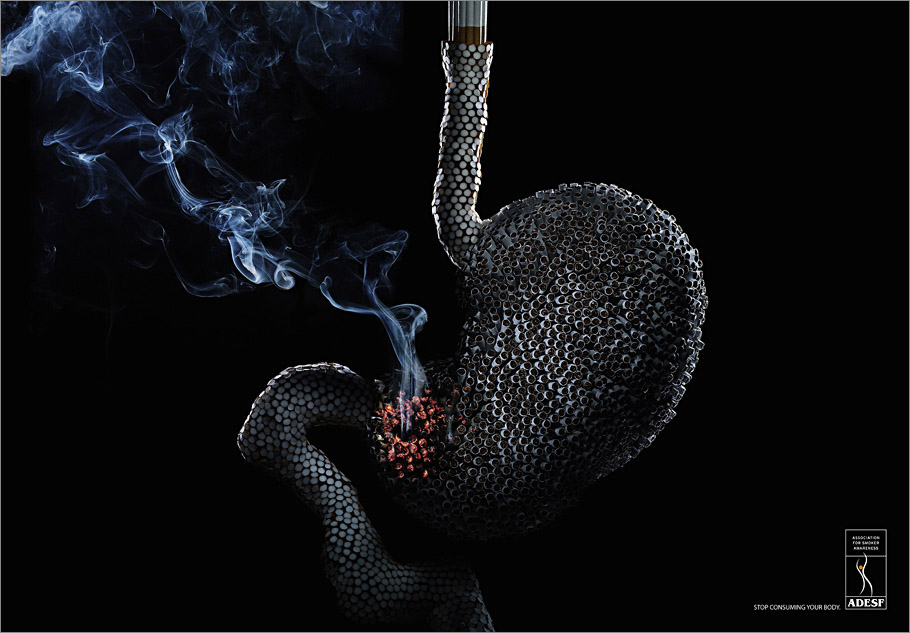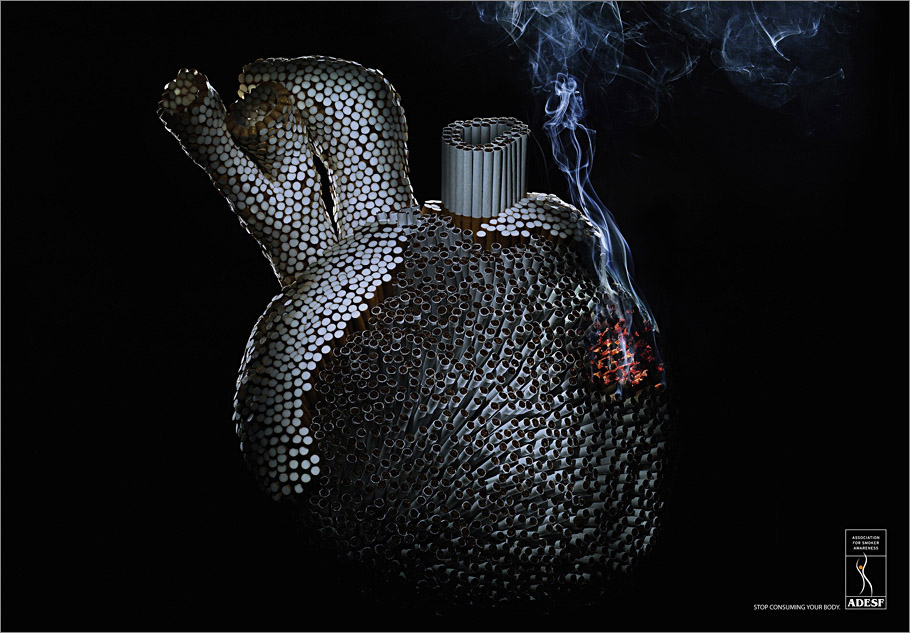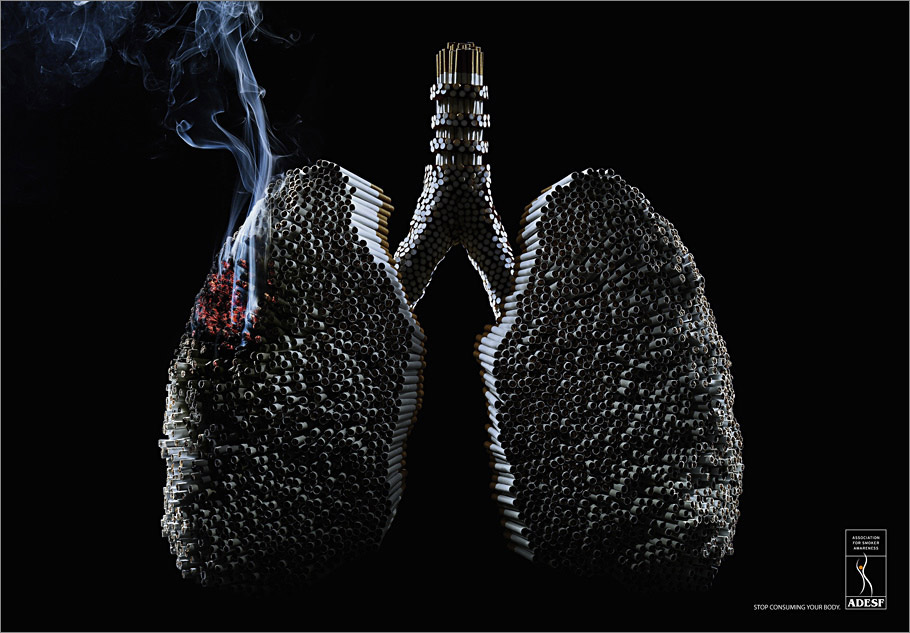An unofficial blog about the National Museum of Health and Medicine (nee the Army Medical Museum) in Silver Spring, MD. Visit for news about the museum, new projects, musing on the history of medicine and neat pictures.
Saturday, September 13, 2008
AFIP mentioned in two newspaper articles
http://www.nytimes.com/2008/09/09/us/09salvia.html?ex=1378699200&en=aa0342b715969c4c&ei=5124&partner=permalink&exprod=permalink
A urinalysis test developed at the AFIP for Salvia divinorum, a potent hallucinogenic herb, is discussed in "Popularity of a Hallucinogen May Thwart Its Medical Uses," By KEVIN SACK and BRENT McDONALD, New York Times September 9, 2008.
Walter Reed medical center history conference
Call For Papers
Walter Reed Army Medical Center
Centennial Symposium 1909-2009
Date: April 29, 2009
Walter Reed Army Medical Center, Washington, D. C.
Theme: Walter Reed and A Hundred Years of Army Medical Care
Background: On May 1, 1909, medical officials transported patients from the old and condemned, Washington Barracks General Hospital to the newly constructed Walter Reed General Hospital, and thus began the legacy of this world recognized military medical institution.
Papers: Papers should focus on the significance of Maj. Walter Reed, the army physician, or Walter Reed Army Medical and its medical institutions and history.
Participants are to submit a prospectus that includes the title of the paper, thesis or theme, overview and a brief bibliography.
Prospectus: Due December 1, 2008
Send to:
Sherman Fleek
Command Historian
Walter Reed Army Medical Center
Office Public Affairs
6900 Georgia Ave. NW
Washington DC, 20307-5001
202.782.3329
Sherman.fleek@amedd.army.mil
Tuesday, September 9, 2008
Military funeral at Arlington
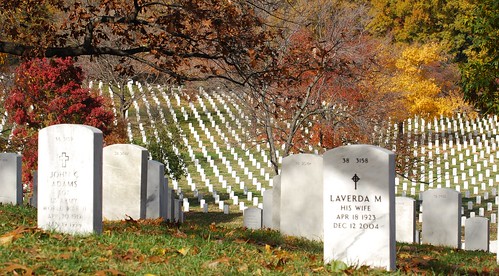 "
"A woman emailed me a couple of months ago, asking if she could use one or two of my Flickr photos in a video she wanted to make to honor her father, who was buried at Arlington National Cemetery last spring. Of course I said yes, and went back to the cemetery to take some specific pictures for her. Please take a few minutes to watch her video and see parts of this iconic cemetery that needs just a one-word name: Arlington.
The cemetery's official website has details of its fascinating history that dates to America's Civil War. I think we who live here may take it for granted, but it really is a special, sacred place.
Friday, September 5, 2008
Did Daniel Sickles visit his leg in the Museum?
Here's a bit I ran across a few years ago. A very old doctor wrote his reminiscences of people who knew in the US Army Medical Department in "Personal Recollections of Some Old Medical Officers" by Henry Crecy Yarrow, Military Surgeon January 1927, pp 73-74:
One day he [Curator George Otis] received a visit from a fine looking gentleman of military bearing, who announced himself as General Dan E. Sickles, and stated that he understood his leg, which had been amputated in consequence of a shell wound received in the battle of Chancellorsville, was on exhibit in the Museum. Dr. Otis replied that it was and with that courteous urbanity of manner for which he was celebrated, invited the General to accompany him to the main hall of the Museum. He pointed out several interesting specimens, but the General, apparently losing patience, said, Oh, yes, yes, but let us come to my leg!" They finally reached the case where the leg was exhibited and the General examined it very carefully for a few moments, when he turned to Otis and said with some harshness, "Where is my foot?" What have you done with my foot -- that should have been shown too." Otis replied that there seemed to be no necessity for saving the foot as the part saved showed why a surgical operation was necessary. The General became very angry and anathematized the museum very freely."
Diabetes and hearing loss
"The link between diabetes and hearing loss was evident across all frequencies, with a stronger association in the high frequency range. Mild or greater hearing impairment of low- or mid-frequency sounds in the worse ear was about 21 percent in 399 adults with diabetes compared to about 9 percent in 4,741 adults without diabetes. For high frequency sounds, mild or greater hearing impairment in the worse ear was 54 percent in those with diabetes compared to 32 percent in those who did not have the disease."
How does Agent Orange fit in? As I noted in a prior post, the Veterans' Administration has stipulated that Agent Orange causes diabetes. So, once again, all of you Vietnam vets out there - if you have health problems, contact the VA.
Thursday, September 4, 2008
Make your own museum specimens

With Halloween a few weeks away, those inspired by the rows of "wet specimens" at the museum can make their own at home!
RESOLVED exhibit spotlighted today
- At the Danger Room blog, brought to you by the people at Wired magazine, they were nice enough to link to the exhibition's Web site
- Medical News Today published the news release today, too.
Tuesday, September 2, 2008
Links to Pass The Time
- Street Anatomy had word of a 4-d human atlas. Want one.
- Wired's Danger Room blog points to a story about emergency blood protocols.
- Bioephemera visited our Neuroanatomical Collection and took some great photos.
- Civil War Women introduced us to nurse Isabella Fogg of Maine.
Saturday, August 30, 2008
Former museum staffer now shepherds hurricane's PR
Friday, August 29, 2008
From body parts to Rodin sculpture
Thursday, August 28, 2008
We're famous! Sorta.
Engravings du jour
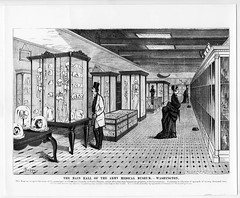
 "All that remains above ground of John Wilkes Booth..." - now that's a guidebook!
"All that remains above ground of John Wilkes Booth..." - now that's a guidebook!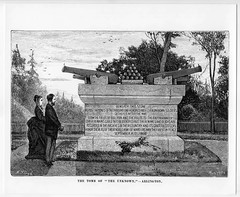
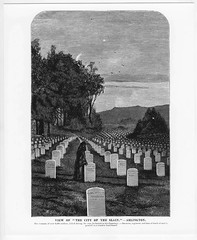 "The City of the Slain"! Talk about accurate!
"The City of the Slain"! Talk about accurate!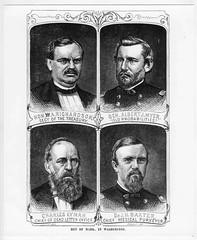
Wednesday, August 27, 2008
We are not alone
More microscope catalogue scans
Graf-Apsco 1938
Graf-Apsco 1943
Graf-Apsco 1946
A new motto for the archives
Monday, August 25, 2008
A collector's estate
A new (tiny) collection in the archives

We recently acquired the Welling Collection – a set of photographs and a PowerPoint presentation – from Col. David Welling, M.D. (retired). Dr. Welling was part of the Critical Care Air Transport Team (CCATT) that was deployed to Yemen to treat and evacuate US sailors injured in the terrorist bombing of the USS Cole. The team was awarded the McKay Trophy, an annual award that the National Aeronautic Association gives to the Air Force person, crew, or organization that makes the most meritorious flight of the year. Dr. Welling said, “The mission was the highlight of my 30-year career.”
The photo above is from Dr. Welling. It shows patients and medical staff inside one of the planes that evacuated the wounded from Yemen to Germany.
Now, a behind-the-scenes peek at the decision about how to handle this collection. We could fold it into the MIS (Medical Illustration Service) collection or make it a collection all its own. The MIS collection is a kind of generic bunch of stuff (which is not to say there’s nothing interesting there – there is plenty interesting) but it’s also 4000 boxes. Bankers’ boxes. It would be easy to “lose” something in there. Plus, the Welling collection was born digital. The only hard copy of anything we had was the disc he sent to us and the emails about it that we printed out.
The other way to treat it – as a collection of its own – would be a consideration even though it’s a one-folder collection. Kind of small for a whole collection, but that’s how we decided to treat it. This is important to us because we have very little contemporary material and we really want to be able to put our hands on it when we need it. By making it a collection we automatically make it a line item on our shelf list (the inventory of our collections) and so it remains higher in visibility of the materials we maintain. We copied the disc Dr. Welling sent us onto a gold archival disc and printed out the photos and the PowerPoint, and all of it will go into a box that holds other small collections right here in the archives.
Thursday, August 21, 2008
NIH wants your great-grandparent
Wednesday, August 20, 2008
More 1918 influenza research leads to pneumonia
Bacterial Pneumonia Caused Most Deaths in 1918 Influenza Pandemic
Implications for Future Pandemic Planning
The majority of deaths during the influenza pandemic of 1918-1919 were not caused by the influenza virus acting alone, report researchers from the National Institute of Allergy and Infectious Diseases (NIAID), part of the National Institutes of Health. Instead, most victims succumbed to bacterial pneumonia following influenza virus infection. The pneumonia was caused when bacteria that normally inhabit the nose and throat invaded the lungs along a pathway created when the virus destroyed the cells that line the bronchial tubes and lungs.
A future influenza pandemic may unfold in a similar manner, say the NIAID authors, whose paper in the Oct. 1 issue of The Journal of Infectious Diseases is now available online. Therefore, the authors conclude, comprehensive pandemic preparations should include not only efforts to produce new or improved influenza vaccines and antiviral drugs but also provisions to stockpile antibiotics and bacterial vaccines as well.
The work presents complementary lines of evidence from the fields of pathology and history of medicine to support this conclusion. "The weight of evidence we examined from both historical and modern analyses of the 1918 influenza pandemic favors a scenario in which viral damage followed by bacterial pneumonia led to the vast majority of deaths," says co-author NIAID Director Anthony S. Fauci, M.D. "In essence, the virus landed the first blow while bacteria delivered the knockout punch."
NIAID co-author and pathologist Jeffery Taubenberger, M.D., Ph.D., examined lung tissue samples from 58 soldiers who died of influenza at various U. S. military bases in 1918 and 1919. The samples, preserved in paraffin blocks, were re-cut and stained to allow microscopic evaluation. Examination revealed a spectrum of tissue damage "ranging from changes characteristic of the primary viral pneumonia and evidence of tissue repair to evidence of severe, acute, secondary bacterial pneumonia," says Dr. Taubenberger. In most cases, he adds, the predominant disease at the time of death appeared to have been bacterial pneumonia. There also was evidence that the virus destroyed the cells lining the bronchial tubes, including cells with protective hair-like projections, or cilia. This loss made other kinds of cells throughout the entire respiratory tract — including cells deep in the lungs — vulnerable to attack by bacteria that migrated down the newly created pathway from the nose and throat.
In a quest to obtain all scientific publications reporting on the pathology and bacteriology of the 1918-1919 influenza pandemic, Dr. Taubenberger and NIAID co-author David Morens, M.D., searched bibliography sources for papers in any language. They also reviewed scientific and medical journals published in English, French and German, and located all papers reporting on autopsies conducted on influenza victims. From a pool of more than 2,000 publications that appeared between 1919 and 1929, the researchers identified 118 key autopsy series reports. In total, the autopsy series they reviewed represented 8,398 individual autopsies conducted in 15 countries.
The published reports "clearly and consistently implicated secondary bacterial pneumonia caused by common upper respiratory flora in most influenza fatalities," says Dr. Morens. Pathologists of the time, he adds, were nearly unanimous in the conviction that deaths were not caused directly by the then-unidentified influenza virus, but rather resulted from severe secondary pneumonia caused by various bacteria. Absent the secondary bacterial infections, many patients might have survived, experts at the time believed. Indeed, the availability of antibiotics during the other influenza pandemics of the 20th century, specifically those of 1957 and 1968, was probably a key factor in the lower number of worldwide deaths during those outbreaks, notes Dr. Morens.
The cause and timing of the next influenza pandemic cannot be predicted with certainty, the authors acknowledge, nor can the virulence of the pandemic influenza virus strain. However, it is possible that — as in 1918 — a similar pattern of viral damage followed by bacterial invasion could unfold, say the authors. Preparations for diagnosing, treating and preventing bacterial pneumonia should be among highest priorities in influenza pandemic planning, they write. "We are encouraged by the fact that pandemic planners are already considering and implementing some of these actions," says Dr. Fauci.
Visit http://www.PandemicFlu.gov for one-stop access to U.S. Government information on avian and pandemic flu.
NIAID conducts and supports research — at NIH, throughout the United States, and worldwide — to study the causes of infectious and immune-mediated diseases, and to develop better means of preventing, diagnosing and treating these illnesses. News releases, fact sheets and other NIAID-related materials are available on the NIAID Web site at http://www.niaid.nih.gov.
The National Institutes of Health (NIH) — The Nation's Medical Research Agency — includes 27 Institutes and Centers and is a component of the U.S. Department of Health and Human Services. It is the primary federal agency for conducting and supporting basic, clinical and translational medical research, and it investigates the causes, treatments, and cures for both common and rare diseases. For more information about NIH and its programs, visit www.nih.gov.Reference: DM Morens et al. Predominant role of bacterial pneumonia as a cause of death in pandemic influenza: Implications for pandemic influenza preparedness. The Journal of Infectious Diseases DOI: 10.1086/591708 (2008).
Save the Date: Stigma of Leprosy Discussion, Wed., 8/27, 2pm in the Museum
Afternoon Coffee Talk at the National Museum of Health and Medicine
"Carville: The Landscape of Stigma" with guest speaker Elizabeth Schexnyder, Curator, The National Hansen's Disease Museum.
Join a discussion on how the fear of leprosy led to displays of stigma associated with the disease. Learn how "othering" human beings diagnosed with leprosy shaped the unique social and physical landscape of the National Leprosarium at Carville, Louisiana. After the talk, visit the temporary exhibition 'Triumph at Carville: A Tale of Leprosy in America.'
When: Wednesday, August 27, 2:00-3:00 p.m.
Where: Russell Auditorium (in the Museum, Bldg. 54)
Cost: FREE!! Coffee!!
Tuesday, August 19, 2008
A day in the life...
Dr. King was in his early 80s, and lively and full of interesting stories about veterinary pathology and how there are some controversies in the field like the bursting aortas of racehorses (which I'd never heard of - the competing theories are high blood pressure v. King's compressing the chest when collapsing or mating). He's also a collector of veterinary instruments and brought down some for us.
When I mentioned this collection coming in, I didn't tell you readers that it's 48,000 35mm slides in 108 notebooks, arranged by animal and pathology (ie herpes, heart disease, liver failure). Cool, huh?
Midday was a tour for Lauren the intern's mom. It's always fun to take people that are interested on a tour. Lauren's done a great job for us this summer, working most recently on updating the Vorwald Collection finding aid and adding more material into the trade literature collection (ie advertising), General Medical Products Information Collection.
Later on in the day, we got a call from people doing renovations in the area the AFIP director works in and so we removed paintings of the former directors for safe storage while the work goes on.
Saturday, August 16, 2008
Trigeminal neuralgia
AFIP medical examiners mentioned in Post and Times
The AFIP isn't mentioned by name in either article which is typical. The Armed Forces DNA Identification Laboratory (AFDIL) is, but they are a component of the Office of the Armed Forces Medical Examiner, which in turn falls under the AFIP. And the medical examiners would have done the fingerprint work mentioned in the Post article, not the DNA technicians.
Remember, the museum has on display Resolved, an exhibit on forensic identification of military dead that's just opened.
Ford's Theatre renovation and reopening

A museum in Ford's Theatre is mentioned in passing in this article "The History Will Linger At Remade Ford's Theatre," By Michael E. Ruane, Washington Post Staff Writer, Friday, August 15, 2008; Page A01.
Ruane wrote, "The government bought the theater from Ford and used it over the years as a museum and as an office and storage building."
Well, that was the Army Medical Museum which was there for almost two decades, before it moved to a new bulding on the Mall (which was knocked down in 1968 for the Hirschorn). I wrote about the Museum there in Washington History (available from the Washington Historical Society) last year. Here's some relevant paragraphs edited down somewhat:
After President Lincoln's assassination in 1865, the federal government purchased and renovated the notorious Ford's Theatre to house the museum, the Surgeon General's Library, and the more than 16,000 bound volumes of the Records and Pension Division of the Surgeon General's Office. The move to Ford's Theatre in December 1866 permitted the museum to expand its collecting to include Native American weapons and “specimens of comparative anatomy.” Now the museum, with its larger exhibit space and broader scope, would become a well-known Washington-area landmark.

The museum had no difficulty attracting the public. Medical specimens, including many anomalies and curiosities, fascinated both lay and professional visitors alike. No doubt part of the fascination lay in the innate morbid curiosity of seeing human remains usually available in circus side-shows, but the Civil War had just ended, and the displays of specimens from maimed soldiers of both sides led visitors to see the museum as an unintentional national memorial. The glass cases of specimens were flanked by flags and standards of ambulances corps as well as Union and Confederate swords and sabers. While the displays were systematic, rather than artistic, they were nonetheless alluring, especially for thrill-seekers. A reporter for the popular Appleton’s Journal captured the atmosphere:
It is, indeed, not such a collection as the timid would care to visit at midnight, and alone. Fancy the pale moonlight lighting up with a bluish tinge, the blanched skeletons and grinning skulls — the same moon that saw, in many a case, the death-blow given, or the bullet pierce. The thought is not a comforting one, and those fancies would not be calculated, at such a time, to inspire courage. But in broad daylight, with the sun shining outside, and brightening up, with its tinge of life and activity, the tessellated floor, with the noise and traffic of the street outside, and the hum and murmur of numerous clerks and attendants inside, even those of timid proclivities do not then hesitate to inspect closely and with curiosity the objects which, twelve hours later, when the building is dark and deserted, they would scarce care to approach.

Opened to the public on April 16, 1867, the museum drew around 6,000 visitors by the end of the year. “It cannot fail to be one of the most absorbing spots on earth to the student of surgery or medicine,” opined guidebook author Mary Clemmer Ames in 1874, “but to the unscientific mind, especially to one still aching with the memories of war, it must remain a museum of horrors. . . . No! the Museum is a very interesting, but can never be a popular place to visit." In spite, or because, of Ames's concerns, by 1874, the number of visitors sometimes reached more than 2,600 per month, even the museum was only open from 10 am to 3 pm on weekdays, and on Saturday from 10 am to 2 pm. As early as 1866, the museum was well-known enough to be mentioned in Atlantic Monthly. In Dr. S. Weir Mitchell's fictional story, "The Case of George Dedlow," the hero, who lost both legs due to the war, was contacted by spirits during a séance. The spirits proved to be his amputated limbs, preserved in the Medical Museum: "A strange sense of wonder filled [Dedlow], and, to the amazement of every one, I arose, and, staggering a little, walked across the room on limbs invisible to them or me. It was no wonder I staggered, for, as I briefly reflected, my legs had been nine months in the strongest alcohol." Undoubtedly, readers of the story would have wished to visit the museum to look for the imaginary Dedlow's limbs.

As early as 1880, the Ford's Theatre building was proving inadequate for the expanding museum and library. In fact one exterior wall as falling away, and eventually the interior floors collapsed after the museum had moved out. In 1881 the museum attracted 40,000 visitors, while in 1888, the library had 5,000 readers. In his annual message to Congress, President Rutherford Hayes asked for an appropriation to replace the building. “The collection of books, specimens, and records constituting the Army Medical Museum and Library are of national importance. . . ,” Hayes wrote. “Their destruction would be an irreparable loss not only to the United States but to the world.”
Some congressmen opposed the idea of a new building, suggesting instead that the Army's medical records merge with the Pension Bureau's in their new building (now the National Building Museum), or amalgam the library with the Library of Congress and the museum with the Smithsonian Institution. Representative Clarkson Potter of New York objected on emotional grounds and opposed funding the museum and “preserving the relics and bones or wounds caused by the war at any place in our capital,” wishing instead that "they were all buried and covered all over with green grass and hidden from sight forever." On the other side, the more forward-thinking Representative Theodore Lyman of Massachusetts envisioned an institution something like today’s National Institutes of Health and "discern[ed] a hope that , , , germs may be used for inoculation and may protect us from . . . diseases, just as vaccination protects against smallpox.” Lyman deemed the museum’s studies “essential to the welfare of our people,” and the library “now the first in the world, and whose not less admirable collection of military pathology, are placed at the disposal of all investigators.”
The full article, "The Rise and Fall of the Army Medical Museum," has much more information in it of course.
To show that nothing really changes, we're currently scheduled to move off of Walter Reed Army Medical Center's DC campus due to the BRAC closure of the base, but no new home has been designated for us.
Ruane also wrote, "On the morning of June 9, 1893, the building was packed with 500 government clerks, occupying several floors of jury-rigged office space, when the interior collapsed, according to a Washington Post account the next day. Scores were killed and injured, and the theater's already altered interior was destroyed."
The space wasn't jury-rigged - actually it was built of cast iron, fireproof construction, but the space wasn't strong enough for all the tons of pension records that were being stored there.
Tuesday, August 12, 2008
Unknown

The ship exploded and all hands, 229 of them, were lost. Seventeen years later their bodies were repatriated and buried in section 24 of Arlington, near the mast of the Maine. Their names are engraved on the foundation of the memorial.

A sad story in and of itself, but the most poignant part is when you walk among the tombstones and see this. Our Resolved exhibit shows how far we've come and made this kind of memorial obsolete.

Saturday, August 9, 2008
Another view of our Resolved exhibit

I think this is my favorite view of the exhibit. That's a transfer case draped with a flag and a backdrop from the Joint POW/MIA Accounting Command Forensic Anthropology Lab at Hickam AFB in Hawaii, showing the process of reconstructing human skeletons with the aim of identification. I always assumed it was a casket that brought our soldiers home, but it's not. The same grim purpose, a more utilitarian box.
Friday, August 8, 2008
Military medicine training article
Wednesday, August 6, 2008
1918 flu comic for downloading

In my private life, I dabble in comic art history. Dave Lasky's done a comic book "No Ordinary Flu" about the 1918 influenza epidemic for King County in Washington State. You can download it as a pdf in multiple languages. Their website reads:
To promote pandemic flu preparedness, Public Health - Seattle & King County has developed a 12-page comic book on pandemic flu. Targeting readers of all ages, this story tells the tale of a family’s experience of the 1918 influenza pandemic. It also explains the threat of pandemic flu today, illustrates what to expect during a pandemic (such as school closures), and offers tips to help households prepare.
You can also hear Lasky on KUOW's Sound Focus for August 6th - "No Ordinary Flu and Recipes for Peaches." Here's a direct link.
Thanks to cartoonists Scott Gilbert and Scott Faulkner for the tips!
Is there any place for human remains in a museum (these days)?



Mike's post yesterday about a conference at which the title of this post will be discussed leads me to show you these pictures. They're all from our Resolved exhibit on identifying human remains. I'll show more pictures of the exhibit in future posts, but try to imagine the gaps if these body parts, out of squeamishness or political correctness, were no longer in our collection. Imagine our anatomical collections manager trying to explain, in words alone, how a female and male pelvis are different. Or what the mandible of a child of a particular age looks like (remember, no objects for illustration). Or the differences among the skulls of Europeans, Asians, and Africans. I'm still kind of new to the museum game as an employee, but as a long-time museum-goer, I think there's not a lot of place for this kind of question from museum professionals.
Tuesday, August 5, 2008
Human remains symposium in Paris text online
first round-table : repatriating human remains: why, for whom, under which conditions?
second round-table : Is there any place today for human remains inside museums?
third round table : the status of human remains from a legal, ethical and philosophical point of view
fourth round table : How to reach a mutual understanding? Institutional mediations and negotiations
Obviously the phrasing of the 2nd round-table just bugs me right away. Why shouldn't there be a place for human remains in a museum? I don't particularly care if mine end up there, and former museum pathologist Daniel Lamb insisted on it.
The whole text of the symposium is downloadable and I'm looking forward to reading it.
War Surgery in Afghanistan and Iraq featured by New York Times
The article about the atlas of injuries is "To Heal the Wounded," By DONALD G. McNEIL Jr., New York Times August 5, 2008
There's also audio files linked to on the main page, as well as photographs.
Limb lab continuation - that Civil War amputee
Here's the medical museum's photograph of Stratton:
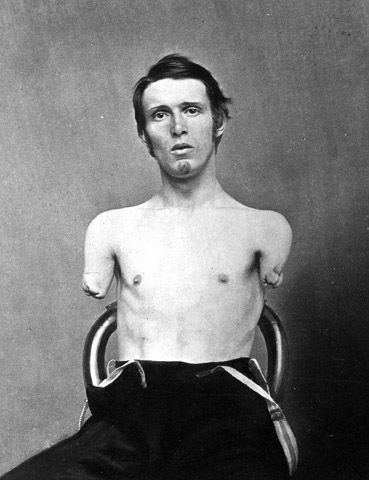
And the cartes-de-visite Stratton sold to support himself:
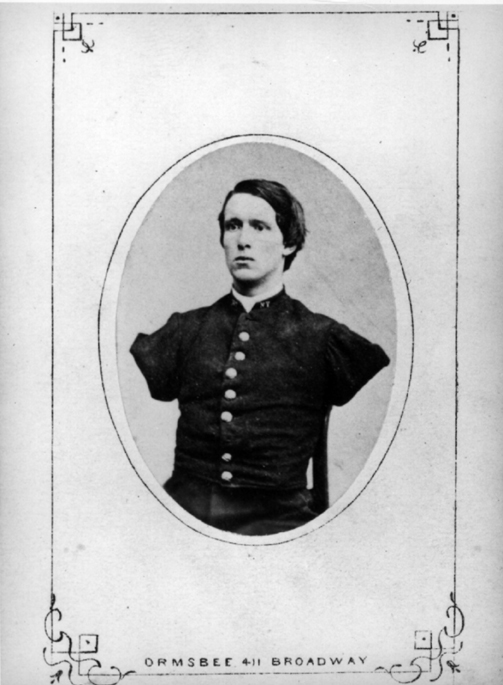
This paper has pretty much everything I know about the Museum's Civil War photography and is one of my favorites of articles I've written.
Monday, August 4, 2008
Complicated grief
This discovery also explains why these people don't respond to traditional remedies for depression, which act on a different brain system involving serotonin. Scientists thing that a drug that acts on dopamine, which is involved with the nucleus accumbens, might be more effective.
Limb Lab presentation report at blog
Appalling practice by US hospitals reported by Times
Many hospitals are taking it upon themselves to repatriate seriously injured or ill immigrants because nursing homes won't accept them without insurance.
Surgeon General's Lecture Series at 1100 on 8 August 2008 in Memorial Auditorium, NNMC, Bethesda, MD
This is just a reminder that the Surgeon General's Speaker Series is set to continue on 8 August 2008 at 11:00 AM in Memorial Auditorium at the National Naval Medical Center, in Bethesda, MD. The lecture, "Jonathan Messersmith Foltz: Colorful Naval Surgeon and Friend and Foe of President James Buchanan," will be delivered by Ludwig Deppisch, MD, author of the recently acclaimed book, The White House Physician: A History from Washington to George W. Bush. This lecture will be open to all who wish to attend. As a note, this talk will hold special appeal to anyone interested in mid-nineteenth century American political and naval history. The subject of the lecture is a notable Victorian-era Navy surgeon who was linked to many famous literary, political, and scientific figures of his day including President James Buchanan, Admiral David Farragut, Samuel Morse, Edgar Allan Poe, and Queen Victoria. Dr. Foltz served as the first military White House physician, a Fleet Surgeon with Admiral David Farragut at the Battle of Mobile Bay, and in 1871 he was appointed as the Surgeon General of the Navy (becoming only the second person to hold that post).
André B. Sobocinski
Deputy Historian/ Publications Manager
Office of the Historian
Bureau of Medicine and Surgery (BUMED)
Tel: (202) 762-3244
Fax: (202) 762-3380
E-Mail: Andre.Sobocinski@med.navy.mil
http://navyhistory.med.navy.mil/
Moulage instruction booklet
Friday, August 1, 2008
Mid-Atlantic history of medicine seminar
Announcing the 6th Annual Joint Atlantic Seminar for the History of
Medicine, to be held the weekend of September 26-27, 2008, and hosted
by the Section of the History of Medicine and the Program in the
History of Science and Medicine at Yale University in New Haven, CT.
The seminar is organized and coordinated by graduate students across
North America working in fields related to the history of medicine.
Our mission is to foster a sense of community and provide a forum for
sharing and critiquing graduate research by peers from a variety of
institutions and backgrounds.
There is no fee for the Seminar, but registration is required.
The deadline for registration is September 10, 2008.
Please email Julia Irwin at JASMed2008@gmail.com to register.
For further information, see our website at www.jointatlantic.org
Wednesday, July 30, 2008
Establishing identity

Here's another shot from our Resolved exhibit. It shows the lines of evidence that must be explored in order to establish identity.
Forensic identification is the application of science to establish personal identity.
Postmortem data are an individual's physical characteristics recorded by scientists from a person's remains after death.
Antemortem data are the physical characteristics that a person is born with and acquires throughout life.
Identification results when a person's postmortem data matches an individual's antemortem data to the exclusion of everyone else.
Lines of evidence are those scientific disciplines that contribute to an identification, such as material evidence, fingerprinting, dentistry, anthropology, DNA, and pathology.
A case is resolved when an American returns alive, the remains are recovered, repatriated, and certified, or there is convincing evidence that neither of the two options is possible.
Tuesday, July 29, 2008
Neat article on why bacteria can make you sick
Resolved

This image is what greets the visitor at the entrance to our new "Resolved" exhibit on identification of war dead. I think it's universal in language, eloquence without words.
Let's look at a photo
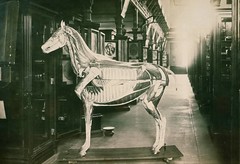
Comparative anatomy, Auzoux model of horse, life size. Specimen no. 2635. [papier mache, on display in Army Medical Museum]. We no longer have the model, although one can be seen in the Science Museum in London.
For many years, models were a way to convey information in medicine and natural sciences. Color printing had to be hand-done, and photography first didn't exist, and then each photograph for a book had to be printed individually and glued into the book. And hand-tinted if required. So well into the 20th century models like Auzoux's above, or ones like this x-ray burn were produced for education.

Breast. Burn, X-Ray. Wax model. No. 92 X-ray burn involving right breast and axilla. Necrosis of tissue producing sloughing ulceration, the bottom of which includes pleura and lung tissue. X-ray treatment was applied for carcinoma of the breast. Colored, woman, age 35 years. Army Medical Museum model prepared by Dr. J.F. Wallis. [Circa World War 1, 1918].
The museum's model-making skills continued into the 1950s, when a technique called moulage, which simulated injuries in rubber overlays were developed. A soldier would put on a moulage of a nuclear radiation injury for example and then the trainees would attempt to treat him. I'll attempt to get some photographs of them up, although I think we scanned the kit's whole instruction book recently as well.
Check out this conference in Europe on models and Auzoux too.
Sunday, July 27, 2008
Memorial to French doctors

This relief is on an exterior wall at the Musée d'Histoire de la Médecine in Paris, kind of tucked away and probably not noticed much. I'm glad I found it. It's a memorial to the 1800 doctors who gave their lives for their country in World War 1.
Friday, July 25, 2008
Victor McKusick, Abraham Lincoln and the Museum
At the moment, the museum is not contemplating DNA tests on Lincoln's remains, nor any other individuals.
Wednesday, July 23, 2008
Reminder: Limb Lab Program Tomorrow
Afternoon Coffee Talk at the National Museum of Health and Medicine
Title: "Limb Labs: Getting Amputee Soldiers Back to Work After World War I"Speakers: Beth Linker, Ph.D., Associate Professor of History, University of Pennsylvania and Jeffrey Reznick, Ph.D., Honorary Research Fellow in the Center for First World War Studies at the University of Birmingham and Director of the Institute for the Study of Occupation and Health, AOTF
What: Join a discussion about early efforts to standardize and construct affordable prosthetic arms and legs for amputee soldiers by orthopedic surgeons in America and England during World War I.
When: Thursday, July 24, 2:00-3:30 p.m.
Where: Classroom (AFIP, Bldg. 54)
http://www.nmhm.washingtondc.museum/about/directions.html
Cost: Free! Coffee!
Tuesday, July 22, 2008
Former museum staffer on weight vs height vs driver's license
He also was wandering around Russia looking into the Czar's assassination.
Monday, July 21, 2008
New exhibit in Museum sheds light on identifying missing soldiers, sailors and airmen
Sunday, July 20, 2008
Urology exhibit in Washington-Baltimore area
Trepanation

You see old illustrations of this procedure and it kind of makes your skin crawl and makes you very glad it's not you under the awl or drill. According to wikipedia, cave paintings as far back as the Neolithic era give the earliest documentation of this medical procedure, used for a variety of disorders from migraines to bad spirits. I can kind of identify with that. I used to get some hellacious headaches and if a hole drilled in my head would have relieved them, I would have signed up on the spot. Trepanation is still used today but a little more circumspectly. Regarding this picture, though, even for my headaches, I would have insisted on a nice, lie-down position. This picture was part of a small museum attached to an excavated 12th century church in Dublin, Ireland.
Saturday, July 19, 2008
Old Walter Reed Hospital
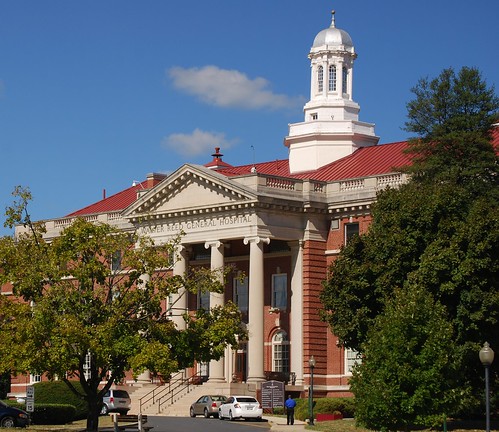
Have I posted this before? I lose track. I was just looking at my Flickr stats and saw that this picture of the old (original) Walter Reed Hospital was viewed several times yesterday. I took this last fall, the second-best time of year to be in Washington. If you haven't been here in spring, put it on your Bucket List. Washington is indescribably beautiful in the spring, but fall is almost as good. Look at the color of that sky.
Wednesday, July 16, 2008
Agent Orange's lasting effects
About three years ago my husband went for a routine physical and got the bad, terrifying news that he was diabetic. Even though I have a sister who's diabetic and I thought I knew all there was to know, it turned out neither Bob nor I knew much of anything. He had no family history whatsoever. Overnight, it seemed, he lost quite a bit of weight because he was afraid to eat anything. The doctor told him no bread, potatoes, rice, or pasta and he gave it all up cold turkey. He manages pretty well now, thanks, but has a pretty good idea of what awaits him down the line.
Now here's the kicker. About a year after he was diagnosed, his brother was trolling the VA website and found information relating diabetes to Agent Orange. The bottom line is, if a soldier set foot in Vietnam and now has diabetes, the VA makes the presumption that Agent Orange is the cause. You don't have to prove anything other than show your DD214. Sure, they make you jump through hoops but if you have it, pass Go and collect your claim. And it's not just diabetes. If you know a Vietnam vet who's having health problems, please direct him or her to the VA website.
SOPs for death of employees
 "
" 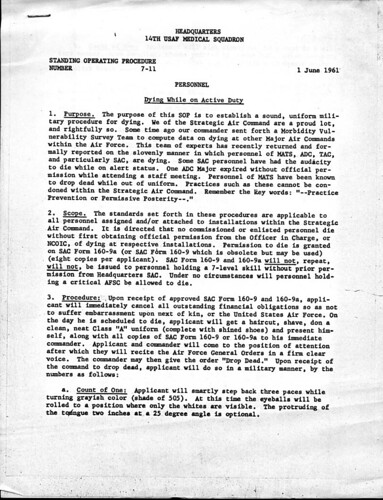 "
"  "
" I've been processing a collection from a former director of the AFIP (Armed Forces Institute of Pathology), a doctor who was in the forefront of aircraft accident investigations, causes, and pathology, back in the late 1950s and early 1960s. Much of the collection relates to papers he wrote and conferences he spoke at and attended, interesting to a certain point, but still... However, among his papers I found these gems that, 50 years on, made me smile. I know you'll have to click through to read them. I think they're worth it.
Tuesday, July 15, 2008
Resolved: The Story of Capt. Robert M. Young and His Return Home
"Resolved: The Story of Capt. Robert M. Young and His Return Home"
In the spring of 1970, a U.S. Army helicopter was hit by enemy fire and
forced to land on the border of Cambodia and South Vietnam. The soldiers
on the aircraft were captured and interred as prisoners of war. In 1973,
several of the soldiers were released while others remained
missing-in-action. Two of the soldiers were found to have died in the
camps. One of these soldiers, Capt. Robert M. Young, left behind a young
wife and three-year-old daughter.
Over 25 years later, Capt. Young's remains were positively identified by
the Central Identification Laboratory through several lines of evidence,
including an examination of anthropological remains and DNA analysis.
This family's story provides a real-life illustration of the process of
identification exhibited in "RESOLVED: Advances in Forensic
Identification of U.S. War Dead."
Monday, July 14, 2008
Afternoon Coffee Talk at the National Museum of Health and Medicine
Title: "Limb Labs: Getting Amputee Soldiers Back to Work After World War I"
Speakers: Beth Linker, Ph.D., Associate Professor of History, University of Pennsylvania and Jeffrey Reznick, Ph.D., Honorary Research Fellow in the Center for First World War Studies at the University of Birmingham and Director of the Institute for the Study of Occupation and Health, AOTF
What: Join a discussion about early efforts to standardize and construct affordable prosthetic arms and legs for amputee soldiers by orthopedic surgeons in America and England during World War I.
When: Thursday, July 24, 2:00-3:30 p.m.
Where: Russell Auditorium (AFIP, Bldg. 54)
http://www.nmhm.washingtondc.museum/about/directions.html
Cost: Free!
Sunday, July 13, 2008
Customer service at museums
Experienceology: Customer service and the visitor experience
"Pioneering Heart Surgeon"
"Michael E. DeBakey, 99, the father of modern cardiovascular surgery, who invented scores of medical procedures and instruments, developed the Mobile Army Surgical Hospital and established what later became the Veterans Affairs hospital system, died July 11 at Methodist Hospital in Houston. The hospital did not release the cause of death, but he had undergone heart surgery in 2006."
There are numerous posts out there about DeBakey, but I thought it was worth linking to this brief note from the crew at NPR's Science Friday.
Thursday, July 10, 2008
The Vietnam Center and Archive Blog
The Vietnam Center and Archive Blog
The Vietnam Center and Archive is proud to announce the launch of our new blog located at http://www.vietnamarchive.blogspot.com. This blog will be used for a variety of topics and will be updated often by members of the Vietnam Center and Archive staff.
Blog topics will include: Vietnam Center and Archive news and updates, information about the Oral History Program, updates concerning the Virtual Vietnam Archive and the physical archive, interesting items from our holdings, website updates, and reference resources and outreach. We hope this new blog will both be a way to keep people informed about the progress of the Vietnam Center and Archive, as well as provide a valuable research tool. Several articles have already been posted, so
please visit our blog and leave us your comments.
A link to our blog is also located in the top right corner of our website [http://www.vietnam.ttu.edu].
Mary McLain Saffell, C.A.
Associate Director, Archivist
The Vietnam Center and Archive
Texas Tech University
Special Collections Library, Room 108
Lubbock, Texas 79409-1041
A day in the life...

Turned on the computer this morning and saw the screen above and this email...
Effective immediately, when you log onto the AFIP network you will see a New DOD Consent Banner and User Agreement. Please take a moment to read this banner, by clicking ok you are in agreement with the consent banner.
The new warning and consent banner establishes that there is no expectation of PRIVACY when using DOD Information systems and all use of the Information system is subject to searches, audits, seizure, and monitoring.
In the past the helpdesk personnel have waited many hours to implement needed updates for security and software. This new banner makes it clear that when such needs arise the systems can be accessed by the personnel without prior notification. However, we will continue to make courtesy calls unless restricted by deadlines.
If for some reason you are not in agreement with the new banner and user agreement you will NOT have access to Information systems within the organization. This is a directive of MEDCOM, which means we MUST follow it. I can hardly contain my enthusiasm for seeing that message every day, or working for people whose level of trust mandates it.
Later in the afternoon, Kathleen and I went down to the Borden Institute, which publishes the Textbook of Military Medicine series, to work on a picture book on the history of Walter Reed medical center. With the other editors, we culled some of the photos from the 'teens and twenties chapters as we had too many.
A Flickr / Getty Images deal in the works?
Wednesday, July 9, 2008
Do Not Smoke
Stop Consuming Your Body
“Stop Consuming Your Body”
Advertising Agency: NeogamaBBH, Brazil
Art Director: Sidney Araújo
Copywriter: Alexandre Gama
Leprosy Stigma
Afternoon Coffee Talk at the NMHM
What: Lecture, "Carville, the Landscape of Stigma," by Elizabeth Schexnyder, Curator, The National Hansen's Disease Museum
When: Wednesday, August 27, 2:00 p.m.
Where: Russell Auditorium, National Museum of Health and MedicineLeprosy is known as the "Biblical" disease and has been associated with a stigma that affects the lives of those with leprosy, both physically and socially. Did you know that at one time Coca Cola refused to pick up empty Coke bottles from the National Leprosarium in Carville, Louisiana for fear that contact with the bottles might spread the disease? Join Elizabeth Schexnyder, curator of the National Hansen's Disease Museum, for a discussion of the meaning and significance of the social response to leprosy in the development of the National Leprosarium in Carville, Louisiana. She will describe how the process of "othering" human beings diagnosed with leprosy along with the socio-historical factors affecting the disease stigma shaped the unique landscape--both social and physical--of the National Leprosarium.
Tuesday, July 8, 2008
Jim Cassedy lecture at National Library of Medicine
NATIONAL LIBRARY OF MEDICINE,
History of Medicine Division Seminar - First Annual James Cassedy
Memorial Lecture Tuesday, July 15, 2008, 2-3:30pm (Note Revised Date)
Lister Hill Center Auditorium, Bldg 38A, NLM Bethesda, MD
"Medicine by the Numbers: Revisiting James Cassedy's America."
Robert Martensen, MD, PhD
Director, Office of NIH History
To honor the distinguished historian of medicine and long-time National Library of Medicine staffer Jim Cassedy, the History of Medicine Division at NLM is sponsoring the first annual James Cassedy Memorial Lecture. The first speaker will be Robert Martensen, MD, PhD, who will speak on "Medicine by the Numbers: Revisiting James Cassedy's America."
During his long career, Cassedy repeatedly explored the rich history of counting and calculating that preoccupied many mid-19th century American physicians. While numerical inquiries had long interested social historians and demographers, Cassedy's American Medicine and Statistical Thinking, 1800-1860 (1984) and Medicine and American Growth, 1800-1860 (1986) stimulated intellectual historians to analyze how and why our medical forbears embraced statistics. In this talk, Martensen re-visits
Cassedy's mid-century accounts and explores how physicians re-defined medical arithmetic as medicine turned increasingly to laboratory science in the century's closing decades.
All are Welcome
Note: The next history of medicine seminar will be on Thursday, July 24, 2-3:30pm in the Lister Hill Visitor's Center NLM's Bldg 38A. Doctoral candidate Chin Jou of Princeton University will speak on "Prescribing Bodies: Medical Critiques of Fat and Thin, 1890-1930."
Sunday, July 6, 2008
Cool article on London's archeological skeletons
Museum of London's skeleton key to the bodies under city's streets
Tens of thousands of skeletons that lie hidden beneath the streets, houses and offices of London have been revealed for the first time on a map, in a collaboration between the Museum of London and The Times.
Monday, June 30, 2008
When robots operate
The invasion of the surgeon robots. - By Kent Sepkowitz - Slate Magazine: "There is one realm, however, in which robots really are joining the gang: the operating room. It turns out that Americans love to be operated upon by them. Last year, robots participated in thousands of surgeries, and the years ahead promise even more choices. Cancer surgery, heart surgery, brain surgery, you name it—R2-D2 awaits your call. The robots even have their own medical journal (OK, it's run by the humans who operate the robots, but egad!)."
Friday, June 27, 2008
Eakins' The Gross Clinic

The Philadelphia Museum of Art will bring back The Gross Clinic this summer. According to the latest newsletter, it is "described by some as the most important painting by any nineteenth-century American artist." It will be exhibited in gallery 119 from August 2 until February 2009. Read more about the painting itself, including how it was nearly lost to Philadelphia, at wikipedia.
Thursday, June 26, 2008
Acupuncture


Here's a mannequin from the History of Medicine Museum in Paris that I think is pretty neat. If I read the French correctly, the label says it shows acupuncture points. The other picture is a close-up of some cards that are in the case with the mannequin.
For those of you without personal acupuncture experience and perhaps doubt that it really can work, let me tell you it does. My husband always said he'd quit smoking when cigarettes hit $1 a pack. Of course, this was a very long time ago, and also of course, easier said than done. But he heard about a doctor in Austin or Houston, I don't remember now, who performed acupuncture and for $50 decided to give the guy a try. The doctor put one little staple-looking thing in Bob's ear, in that ridge of cartilage, put a piece of tape over it, and told him to leave it until it fell out. About a week later it did, but from the time the staple went in, Bob never smoked again. He said the cravings came and went in a flash, more quickly than he even had time to think about them, and gradually faded away. Amazing, isn't it? I'm a believer.
Rhode hasn't been here cracking the whip


and so postings to this blog have gotten pretty slack. But he's back now and trying to make us all feel guilty. It's working.
Well, as I promised, or warned, depending how you want to look at it, here are a couple of pictures of kidney stone removal tools. (I wish they were a little sharper, but you do what you can with what you have. In this case, the camera was hand-held.) If these don't make you get your 128 ounces of water every day, I don't know what will.
Wednesday, June 18, 2008
Flickr - we are not alone
Tuesday, June 17, 2008
Wow. Wow. Wow.
Human egg makes accidental debut on camera: "Look closely: this is history in the making. These are the clearest pictures ever taken of what is the starting point of every human life: ovulation occurring inside a woman's body."
Human ovulation captured on film: "Following the publication last week of the best ever photos of the ovulation of a human egg, we now go, Fantastic Voyage-like, to the first video footage of the moment itself."
Thanks to New Scientist for bringing this to us.
Mememto Mori, or, The Head of Janus


I made a rewarding visit to the Musée d'Histoire de la Médecine in Paris last month, but thoroughly grossing out my husband with its extensive exhibits of surgical tools, including kidney stone extractors. Not something that a man who has had a kidney stone especially wants to look at. I've not had kidney stones, and I found the tools and illustrations painful to look at, and I've seen some pretty gross things in the course of my job. Do you want to see them? Next time.
I really liked this ivory carving from the 17th century, called the Head of Janus. I don't know if the Catholic school I went to didn't teach mythology as a matter of theology or what, but I never learned about the myths. So wikipedia to the rescue: "Janus was usually depicted with two heads (not faces) looking in opposite directions, and was frequently used to symbolize change and transitions such as the progression of past to future, of one condition to another, of one vision to another, the growing up of young people, and of one universe to another. He was also known as the figure representing time because he could see into the past with one face and into the future with the other."
There's nothing that says transition from one condition to another like a face on one side and a skull on the other.
Telemedicine, literally
While human interaction is still necessary because self-reporting isn't always reliable, allowing patients to text-message results from their urine tests - and get free minutes as a reward - apparently gets better participation during the six-month regimen.
Companion Animals for Stress Response - program at Walter Reed

This came in via email today, but before you get to it, let me introduce you to a companion animal I met one day at lunch, Georgia the assistance dog ---->:
Her "uncle," the brother of the patient who Georgia assists, let me take several pictures of her while she was out for some exercise. She's a beauty and full of energy. I think it was very hard for her to lie still for 30 seconds.
Now, back to our sponsor:
Dear Friends of CAMP PTSD,
Please join us for our next program, Benefits of Companion Animals for
Stress Response on Thursday June 26, 2008 at 4:30pm - 6pm at the Joel
Auditorium at Walter Reed Army Medical Center.
Our presenters are:
* Kevin Simpson, Director of Animal Behavior and Training at the
Washington Humane Society, and
* Joan Esnayra, Phd, Founder of the Psychiatric Dog Service
Society
Please forward this message to anyone you know who may be interested in
this fascinating program.
To RSVP, contact Elsyse Greenberg at elyse.greenberg@amedd.army.mil
Hope to see you there!
Robin Carnes, Chair
Complementary and Adjunctive Medicine Practitioners PTSD Study Group at
Walter Reed Army Medical Center
(240-423-8544)
CAMP PTSD Study Group
Monday, June 16, 2008
A Day in the Life...
Here's one from a few weeks ago. We're part of the Armed Forces Institute of Pathology (see the sidebar history) and their Radiology Department had a lead on some personal papers they were interested in. The American College of Radiology has stored their records with the History Factory in Chantilly, VA, and in their collection they had personal papers of Dr. William Thompson. Thompson was instrumental in setting up the large radiology program at AFIP. The ACR was willing to hand over this series of records to AFIP since it didn't really relate to their core holdings. I tend to wear a dual hat as AFIP's archivist as well as the Museum's so I was on the job.
Poaching from other archives never thrills me, although at times it makes sense. Years ago, we returned photographs of unidentified corpses that we had received from the NY Medical Examiner to the NY Municipal Archives to reunite them with the paper records of the cases. I was fine with that, but there have been plenty of times when people come in to do research and say "wouldn't this be better if it was in..."
Anyway, two people from the radiology dept., and 3 museum staffers took a van from Walter Reed while I drove myself from home. I beat them by about an hour so I hung around with the archivist there. He showed me the collection - it was pretty straightforward personal papers including diaries, some awards and some photographs, both personal and professional. I've seen dozens like it, and at 3 linear feet, it wasn't large. So we talked shop and then when everyone else arrived, they looked at the records. The radiologists were particularly interested as one doesn't see fifty-year old diaries every day, I suppose. We took a quick look in the stacks at the rest of the ACR collection - most archives look alike especially in the 'bulk' storage areas - and I've got to say that they have a nice set of advertising trade literature if you're doing anything on radiology's history. We also looked at the 3-D artifacts because there was some confusion in our party if we were supposed to be checking on them as well.
After signing the paperwork transferring it to us, we headed back to AFIP. Lauren Clark, who's volunteering as an intern this summer, has processed the collection and written a finding aid to it, which should make it onto our regular website soon. There's nothing deeply interesting or dramatic in Thompson's papers, but they help round out the history of radiology at AFIP.
